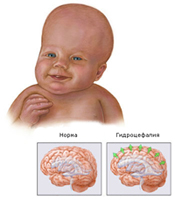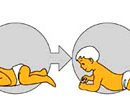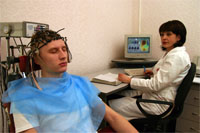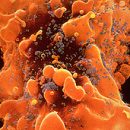Simple measurement of the circle of the head - the method of early diagnosis of hydrocephalus in babies of the first 10 months of life. However, with suspected hydrocephalus, it is necessary to hold a wide range of surveys. Read more in this article.
Content
Diagnosis of hydrocephaliya
 Little children need to measure the circle of the head and chest for the early detection of signs of hydrocephalus: Normally, the monthly increase in the first three months in the intricate child should not exceed 2 cm per month. By the year, the chest circumference should be greater circumference of the child's head approximately 1 cm. In the newborn, an average of the head circumference is 35.5 cm (the normal is considered to be the range 33.0-37.5 cm). In one year old, the child's head circumference is on average equal to 46.6 cm (the boundaries of the norm 44.9 — 48.9 cm). Chest Circle in Newborn - 33— 35 cm. The monthly increase in its size is in the first year of life on average 1.5—2 cm. By the year, the trigger of the chest increases by 15—20 cm. During the examination of children, it should be remembered for the existence of family harassment cases without signs of hydrocephalus.
Little children need to measure the circle of the head and chest for the early detection of signs of hydrocephalus: Normally, the monthly increase in the first three months in the intricate child should not exceed 2 cm per month. By the year, the chest circumference should be greater circumference of the child's head approximately 1 cm. In the newborn, an average of the head circumference is 35.5 cm (the normal is considered to be the range 33.0-37.5 cm). In one year old, the child's head circumference is on average equal to 46.6 cm (the boundaries of the norm 44.9 — 48.9 cm). Chest Circle in Newborn - 33— 35 cm. The monthly increase in its size is in the first year of life on average 1.5—2 cm. By the year, the trigger of the chest increases by 15—20 cm. During the examination of children, it should be remembered for the existence of family harassment cases without signs of hydrocephalus.
If the hydrocephalus of children is suspected, it is necessary to examine the neuropathologist and neurosurgeon. The complex of neurological examination includes the performance of brain ultrasound (neurosonography), if necessary - computed tomography and magnetic resonance imaging. Also need an inspection of the eyepiece. According to the indications, other research methods are prescribed (blood test, electroencephalogram, the study of the spinal fluid and T.D.).
Types of diagnostic research
Ultrasound is a simple, inexpensive examination that helps assess the degree of brain ventricular extension. This procedure applies only when diagnosing children with an open spring, because the skull blocks ultrasound. This method is also useful for intrauterine diagnostics of hydrocephalus.
Computed tomography (CT) - Currently, CT occupies dominant position among the methods of diagnosis of hydrocephalius. This is a teaching technique with a thin beam of the contours of the skull, brain, ventricles and the subfasting space. It is carried out to determine the size and shape of ventricles and detect anomalies of type tumors, cyst or other pathology.
Magnetic resonance (nuclear magnetic resonance NMR) is not an operational method for diagnosing, in which radio signals and magnet are used. According to MRI, the shape and severity of hydrocephalius are determined. These studies are indispensable to clarify the causes of water.
Tsternography (radiography of tight base tanks) is a test requiring the injecting of a radioactive substance in SMZ. It is used to clarify the type of hydrocephalus: reporting or obstructive, as well as to determine the direction of the current of the CM.
Pneumoencephalography is now applied much less frequently than in the past. In some cases, the air is needed using the needle in the spinal cord.
Angiography (radiography of blood vessels) - Special technique for the introduction of a contrast agent in artery crossing the brain. After some time, anomalies are detected at the level of blood vessels and the presence or absence of pathological disorders.
Neuropsychological examination lies in a series of response issues that make it possible to identify the presence of deviations in the work of the brain.









